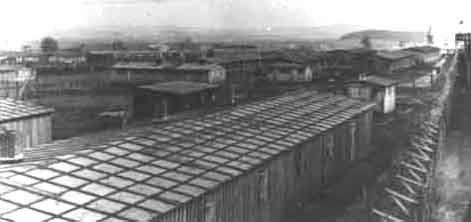Type Prisoner-of-war camp | In use 1940-1945 | |
 | ||
Occupants French, British, and Polish officers | ||
Oflag VI-B was a World War II German prisoner-of-war camp for officers (Offizerlager), located 1 km (0.62 mi) south-west of the village of Dössel (now part of Warburg) in north-western Germany.
Contents
Camp history
The camp was opened in September 1940 on what had been originally intended to be a military airfield. At first French, and then British officers were housed there.
The camp was the setting for two remarkable escape attempts. On 1 December 1941 Flt Lt Peter Stevens RAFVR, disguised as a German Unteroffizier, led a party of 10 POWs disguised as orderlies, and two more disguised as guards complete with dummy rifles, up to the gates of the camp. The sentry was not satisfied with their gate pass, so Stevens marched his party back into the camp. As the sentry was apparently unaware that the party was not genuine, a second attempt was made a week later. This time the sentry demanded to see their Army paybooks, so the escape party fled, although two were arrested.
On 30 August 1942 the camp was the scene of "Operation Olympia", also known as the "Warburg Wire Job", another mass escape attempt. After RAOC officer Major B.D. Skelton ("Skelly") Ginn fused the perimeter floodlights, 41 prisoners carrying four 12-foot (3.7 m) scaling ladders made from bed slats rushed to the barbed-wire fence and clambered over. One ladder collapsed, so of the 41 involved, only 28 escaped the camp, and only three of those made it home.
In September 1942 the British prisoners were transferred to other camps, and were replaced with Polish officers, with 1,077 brought from Romania, where they had been interned since September 1939, and another 1,500 transferred from other camps in Germany.
The British had begun an escape tunnel, and the Poles continued working on it, and on 20 September 1943, 47 of them escaped. Within four days, 20 had been captured and returned to the camp. They were then transported to the Buchenwald concentration camp and executed. In the next few days 17 more were captured and taken to the Gestapo prison in Dortmund where they were killed. Only 10 managed to remain free, some returning to Poland, others finding their way to the Allied lines.
On the night of 27 September 1944 British aircraft attacking the nearby railroad junction in Nörde, dropped some bombs on the camp, killing 90 officers. Altogether 141 prisoners died in Oflag VI-B. They are buried in the cemetery near the centre of the village of Dossel. A memorial was erected there in 1985.
The camp was liberated by the U.S. Army on 3 April 1945.
Aftermath
In 1960 Polish survivors organized the Klub Dösselczyków. Journals of ex-Polish prisoners are kept in the Central Prisoners of War Museum in Łambinowice, near Opole, Poland.
